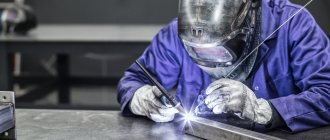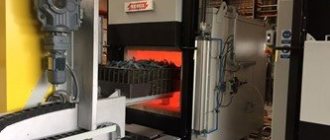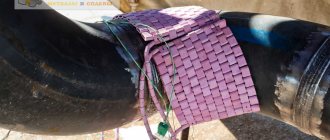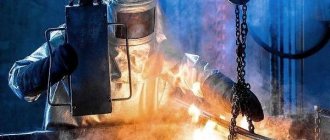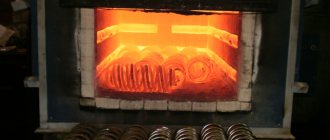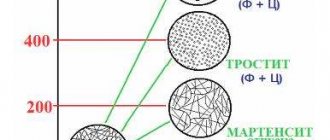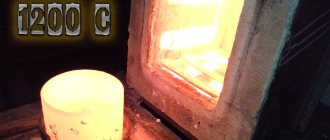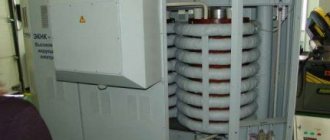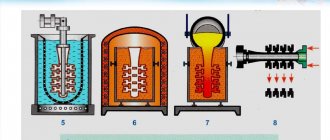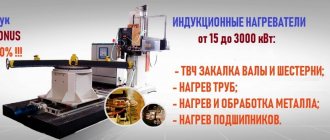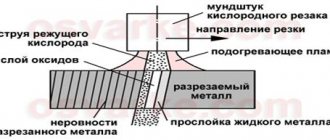What is metal heat treatment called: basics, general principles
In the process of this technology, the crystal lattice of the blank is transformed. The task is to change the properties, not its configuration and dimensions. Upon completion, the workpiece acquires the parameters required by the technology and a unique structure. Let's look at why metal hardening is needed and how it affects the structure of steel after the procedure:
- • to improve technological characteristics through softening, this process is used as a preparatory operation or an intermediate stage;
- • to obtain the required technical characteristics by strengthening or acquiring a specialized structure;
- • to fix the size and configuration, as well as obtain new properties of the workpiece.
All procedures are allowed only on materials in which temperature transformations are carried out in a similar way. Temperature exposure is used for the production of cutting tooling elements, machine tools, machines and production equipment. Answering the question of what types of steel are subject to hardening, we note that the procedure is suitable for metals of any grade that require increased wear resistance.
Specifics of heat treatment of steel 40x
Heat treatment of 40x steel has its own nuances, which are associated with the presence of many impurities in this alloyed metal. Let's consider the temperature conditions of steel processing, the process of hardening, tempering and normalization. Hardness after processing.
The physical properties of materials can be changed by thermal treatment at a high degree of heating and subsequent cooling. This primarily applies to metals that are subjected to hardening. To properly harden steel, you need to know its grade: it reflects the full chemical composition of the solid. Thus, heat treatment of 40x steel has its own nuances associated with the type of impurities contained in it.
If we take the exact definition of the type of steel to which 40x belongs, then this is a classic type of alloyed material, where the percentage of carbon is inferior to the percentage of chromium impurity. These elements here range from 0.44 to 0.36 and from 1.1 to 0.8, respectively. Chromium in the metal contributes to its resistance to aggressive oxidizing environments and gives it the ability not to rust. In addition, chromium affects the mechanical properties of 40x steel, transferring it to the category of structural steel.
Types and their description
Temperature effects are most often applied to steel materials and some alloys. The fundamentals are based on controlling diffusion to obtain structures with given parameters, on polymorphic transformation, and on varying degrees of carbon dissolution. The surface is heated above the critical point, which triggers the transformation in a certain phase. Each has its own critical heating points. These indicators are checked according to the scheme.
Annealing: how it is carried out, temperature, mode for steel, table
This is heating the product, holding it at a certain temperature, and then gradually cooling it to 2-3⁰ per minute. A smooth decrease is possible in sand or in an oven. The process removes residual stress, resulting in a stable structure. Let's look at how it's done below. This procedure is used:
- •to improve ductility and reduce hardness for operations with cutting tools;
- • to eliminate heterogeneity in the structure that arose during the hardening of the casting during its removal;
- • to reduce the stress inside the blank that occurs after mechanical action, pressure and other types of non-thermal treatment;
- • to remove brittleness, improve impact resistance, and change the properties of unriveted parts.
The purpose of steel annealing is to obtain specified technical parameters of the crystal lattice. To do this, the heating is set to 20-30⁰ above the critical point at which the crystal lattice begins to change. For metals, this point is 723⁰С. For large products and workpieces of complex configuration, heating is performed slowly. The mode involves subsequent cooling in accordance with the composition of the material:
- • for carbon ones – 100-200⁰ per hour;
- • for low-carbon ones - 50-60⁰;
- • for highly alloyed ones – longer.
Most cooling is carried out smoothly without removing it from the oven. Full and partial hardening can be used. To remove internal stress, the second type is sufficient. Carbon compounds are heated to 760⁰. During complete annealing, the amount of carbon is taken into account. If its amount does not exceed 0.8%, the temperature is 930-960⁰С, if higher - up to 760⁰С. The holding time depends on the product parameters. Cooling is carried out to 20⁰. After annealing, a quality check of the procedure is necessary. The quality factor of the workpiece is determined by the type of fracture, and the heating mode is determined by the table.
Hardening: modes, main indicators, types and methods for metal and stainless steel
This is a very fast cooling after heating to maximum degrees. It is suitable for obtaining an uneven structure, which gives strength to the material. The procedure is performed sharply, which increases wear resistance. There are several modes. They differ in heating temperature, holding time and cooling rate. The choice of mode is influenced by the chemical characteristics of the steel blank. After the procedure, two main indicators are taken into account:
- Hardening – obtaining hardness. Not all types of raw materials are susceptible to such effects; as a result, the material remains insufficiently hard. The least susceptible are steel blanks, in which the amount of carbon does not exceed 0.3%. The exposure time is determined by color.
- Hardenability. During the process, the surface cools faster than the core of the blank. Coolant quickly removes heat from the surface. The slower the process, the deeper the impact. Its depth depends on the internal structure of the material, the medium used and temperature.
Many people believe that these two procedures are also called heat treatment of metals. This opinion is wrong. Both terms denote the parameters of the hardening process, which determine the quality of the work. We will not describe in detail how the properties of low-carbon steels and color change during hardening; we note that fine-grained products are calcined to a lesser depth than coarse-grained ones. The test is carried out at the fracture, examining the surface structure and hardness.
There are several types depending on the number of media and methods used. Using one type of cooler is not appropriate for all types of ingots. Due to the rapid decrease in heating degrees, strong stress arises in the structure, the temperature is distributed unevenly, which can lead to cracking and bending.
Methods are selected taking into account the composition of the material. Hypereutectoid steel products are best kept in one coolant. Workpieces with complex geometries can be processed in two environments. Initially, they are cooled in water to 400⁰, then placed in oil, leaving in it until completely cooled.
Step hardening prevents accidental cracking and distortion. The product is placed in a bath heated above 250⁰, then dipped in oil or left to cool in air. The procedure is appropriate for blanks made of carbon material with a cross-section of up to 10 mm, as well as large blanks made of alloy steel.
The process isothermal method is performed with liquid salt, providing longer exposure than with the stepwise procedure. This method allows you to cool the workpiece at any speed, the surface does not crack, the part does not warp, and the required viscosity is maintained.
Light is performed in a protective environment. The workpiece is heated in a specialized furnace. To ensure that the surface acquires a light, pure color, the process is performed in stages. The object is heated in sodium chloride, then dipped into molten alkali to cool.
Laser - carried out by lasers at 103 - 104 W/cm2. On the treated base, a hardened strip is formed, consisting of a melting zone, a tempering zone and a heating section. The method is necessary to increase resistance to heat, wear, corrosion and mechanical influence, as well as other indicators. offers a wide range of domestically produced metalworking machines with delivery throughout Russia. The equipment is selected taking into account the purposes.
Metal normalization: process technology, hardening temperature for ordinary and low-carbon steel
The procedure involves heating above the critical point, holding and cooling naturally in air. It allows you to obtain a normalized structure of the material. It is used for various types of surfaces. The temperature must exceed critical values by 50⁰. The holding time is calculated based on the standard: 25 mm of blank thickness per 1 hour.
Large cross-section blanks are heated in a salt bath, following the technology. This allows you to reduce internal stress and avoid deformation and cracking. When surface heating drops below a critical point, rapid cooling in oil or water is possible.
Tempering of steel after hardening: table
It is used after hardening. It is used for metal blanks from which tools will be made. The workpiece is removed from the cooling medium at a certain point before complete cooling occurs. Residual heat from the core escapes, heating the surface. After the specified values are achieved, cooling is continued until it cools completely. The shutter speed characteristics are controlled according to the table.
| Hardness (HRCe) | Temperature, degrees C | Temperature holidays, degrees C | Temperature zak. HDTV, deg.C | Temperature cement., deg. C | Temperature annealing, degrees C | Temper. Wednesday | Note | ||
| 1 | 2 | 3 | 4 | 5 | 6 | 7 | 8 | 9 | 10 |
| 1 | 20 | 57…63 | 790…820 | 160…200 | 920…950 | Water | |||
| 2 | 35 | 30…34 | 830…840 | 490…510 | Water | ||||
| 33…35 | 450…500 | ||||||||
| 42…48 | 180…200 | 860…880 | |||||||
| 3 | 45 | 20…25 | 820…840 | 550…600 | Water | ||||
| 20…28 | 550…580 | Water | |||||||
| 24…28 | 500…550 | ||||||||
| 30…34 | 490…520 | ||||||||
| 42…51 | 180…220 | Sech. up to 40 mm | |||||||
| 49…57 | 200…220 | 840…880 | |||||||
| 670 | Nitriding | ||||||||
| 10 | 7ХГ2ВМ | = 57 | 840…860 | 460…520 | Oil | Sech. up to 100 mm | |||
| 42…46 | Sech. 100..200 mm | ||||||||
| 39…43 | Sech. 200..300 mm | ||||||||
| 37…42 | Sech. 300..500 mm | ||||||||
| НV >= 450 | Nitriding. Sech. St. 70 mm | ||||||||
| 25 | Steel 30HGSA | 19…27 | 890…910 | 660…680 | Oil | ||||
| 27…34 | 580…600 | ||||||||
| 34…39 | 500…540 | ||||||||
| «— | 770…790 | With oven up to 650 | |||||||
| 26 | 12Х18Н9Т | 6 mm water | |||||||
| 29 | 20Х13 | 27…35 | 1050 | 550…600 | Air | ||||
| 43,5…50,5 | 200 | ||||||||
| 30 | 40Х13 | 49,5…56 | 1000…1050 | 200…300 | Oil |
Cryogenic treatment
This is a type of heat treatment of metals that involves processing an object using the influence of low temperature. Liquid nitrogen, boiling at -195.8⁰, is used as a low-temperature medium. The method is appropriate for improving the mechanical characteristics of tool and refractory steels. The procedure improves performance by 1.5-3 times. The advantage is that the process is one-time.
Deep exposure to cold allows maintaining high mechanical properties throughout the entire service life of cutting tools. The cooling-tempering-heating-holding parameters are controlled by a computer. offers a wide range of CNC-based metalworking equipment, including universal and mobile machines. It is possible to purchase equipment on lease.
Thanks to the transformation of retained austenite into martensite, the required strength and wear resistance are ensured. This type at low temperatures is used to stabilize the shape for parts where tolerance errors are not allowed on titanium and aluminum workpieces. An increase in impact strength occurs with the release of carbides of alloying elements. Their number increases as the cryo temperature decreases and the holding period increases. Carbides fill microscopic voids at crack boundaries, making the crystal lattice coherent.
Steel heat treatment modes
Heat treatment is used to eliminate stresses remaining in the product after welding, as well as to improve the structure of the weld metal. After welding or during the welding process, types of heat treatment such as annealing, normalization, and tempering are used.
Heating during annealing of the product in the preliminary furnace is carried out gradually. For low and medium carbon steels the temperature reaches 600-680°C. At this temperature, the steel becomes plastic and stresses are reduced. After heating, it is held at the reached temperature at the rate of 2.5 minutes per 1 mm of thickness of the part being welded, but not less than 30 minutes. Then the product is cooled along with the oven.
There are other types of annealing: local and complete annealing. Annealing modes are selected according to reference literature. Different steels have their own technological annealing parameters.
Normalization differs from annealing in that after annealing the welded structure is cooled in still air. After normalization, the fine-grained structure of the metal is preserved, which makes it possible to ensure its relatively high strength and hardness, but without a stressed state.
Steels with a high carbon content are hardened during the welding process, increasing their hardness and brittleness. Such products made of carbon steels are subjected to normalization followed by tempering. In this case, heating is carried out to 400-700°C, and after that the welded parts are slowly cooled.
When gas welding steels, heat treatment serves as a means of increasing the ductility of the weld metal. In some cases, sections of the seam are heated to a light red heat and in this state they are forged. The metal grains are crushed, ductility and viscosity increase. To avoid the appearance of hardening (a new stressed state), forging should be stopped when the metal cools to a dark red color. After forging, it is necessary to re-normalize.
Steel heat treatment modes
Heat treatment for structures made of carbon and low-alloy steel grades STZsp, St3ps, 20, 25, 30, 25L, ZOL, 20K, 22K, 09G2S, 15GS, 16GS, 20GSL, 1 OXSND, O8GDNFL
- Planting in a “cold” or heated oven to T=200°C.
- Heating at production speed up to T=300°C.
- Exposure at a temperature of 300+25°C for 1-2 hours.
- Heating at a rate of no more than 70°C per hour to T=590°C.
- Exposure at a temperature of 590°C ± 15°C is assigned at the rate of 1 hour for every 25 mm of the largest section of the weld of the structure, rounded up to the whole hour.
In the case of welding samples, the sample is taken at the rate of 1 hour per 25 mm sample depth. The start of exposure should be considered the time when the readings of the furnace or stand-alone thermocouples are in the range of 590°С ± 15°С. Note: If there are structures of different thicknesses in the cage, the shutter speed is assigned according to the maximum thickness.
Heat treatment of austenitic steels, type X18N10T after welding, which require MCC testing
- Planting in a “cold” or heated oven to T=300°C.
- Heating at a rate of no more than 100-120°C per hour to T=850°C.
- Exposure at a temperature of 850°C for thicknesses:
- ⌀ = 10 mm - 2 hours,
- ⌀ = 20 mm - 4 hours,
- ⌀ = 30 mm - 6 hours,
- ⌀ = 50 mm - 8 hours,
- over 50 mm - 10 hours,
- Cooling at a rate of no more than 40°C per hour to T=200°C, further cooling in air.
Note: The holding time is selected based on the largest thickness in the structure. Heat treatment for structures made of carbon steel and 08Х13 steels after welding with EA-39519 electrodes- Planting in a “cold” or heated oven to T-300°C.
Heating at production speed up to T=300°C.
- Holding at a temperature of 300°C - 1 hour.
- Heating at a rate of no more than 50°C per hour to T=680°C.
- Exposure at temperature 680°С ± 10°С for thicknesses:
- ⌀ = 4-50 mm - 3 hours,
- ⌀ = 60-80 mm - 5 hours,
- ⌀ = 90 mm - 8 hours.
- Cooling at a rate of no more than 40°C per hour to T=200°C, further cooling in air.
Note: The holding time is selected based on the largest thickness in the structure. Heat treatment for structures made of carbon and low-alloy steel grades ST3sp, St3ps, 20, 25, 30, 25L, ZOL, 20K, 22K, 09G2S, 15GS, 16GS, 20GSL, 10HSND, 08GDNFL- Planting in a “cold” or heated oven to T=200°C.
Heating at production speed up to T=300°C.
- Hold at a temperature of 300°C ± 25°C for 1-2 hours.
- Heating at a rate of no more than 70°C per hour to T=590°C.
- Exposure at a temperature of 590°C ± 15°C is assigned at the rate of 1 hour for every 25 mm of the largest section of the weld of the structure, rounded up to the whole hour.
- Planting in a “cold” or heated oven to T=200°C.
- Heating at a rate of no more than 70°C per hour to T=620°C ± 10°C.
- Exposure at temperature 620°С ± 10°С for thicknesses:
- ⌀ = 40-70 mm - 4 hours,
- ⌀ = 80 mm - b hours,
- ⌀ = 100 mm - 8 hours,
- ⌀ = 200 mm 10 hours,
- ⌀ = 300 mm - 18 hours.
In the case of welding samples, the sample is taken at the rate of 1 hour per 25 mm sample depth. The start of exposure should be considered the time when the readings of the furnace or stand-alone thermocouples are in the range of 590°С ± 15°С. Note: If there are structures of different thicknesses in the cage, the shutter speed is assigned according to the maximum thickness.
Intermediate heat treatment for structures made of steel ObKh12NZD and O6Kh12NZD-L, after welding with TsL-51 electrodes
Note: The holding time is selected based on the largest thickness in the structure. Final heat treatment for structures made of steel OBKh12NZD and O6Kh12NZD-L, after welding with TsL-51 electrodes
- Planting in a “cold” or heated oven to T=200°C.
Heating at a rate of no more than 70°C per hour to T=630°C ± 10°C.
- ⌀ = 40-70 mm - 4 hours,
- ⌀ = 80 mm - 5 hours,
- ⌀ = 100 mm – 6 hours,
- ⌀ = 200 mm - 10 hours,
- ⌀ = 300 mm - 18 hours.
Note: The holding time is selected based on the largest thickness in the structure. Heat treatment for structures made of steel 08Х13 and 12Х13, after welding with E-12Х13 electrodes
- Planting in a heated oven to T=300°C.
Heating at a rate of no more than 70°C per hour to T=710°C.
- ⌀ = 4-8 mm - 3 hours,
- ⌀ = 10-15 mm - 4 hours,
- ⌀ = 20-30 mm - 5 hours,
- ⌀ = 40 mm - 6 hours,
Note: The holding time is selected based on the largest thickness in the structure.
Advantages of heat treatment as a type of hardening for non-ferrous and ordinary metals and alloys
Various categories are exposed during processing. The advantages of processing include:
- • wear resistance of the metal product;
- • reduction of costs for the manufacture of new parts;
- • reducing the likelihood of defects during production.
• increase in technical indicators of the workpiece;
Carry out in specialized ovens equipped with heating controls. The mode is set in accordance with the hardening characteristics of a certain type of surface.
What is chemical-thermal treatment of metals: general principles and purpose for steel
The technology consists of transforming the outer layer by changing its structure and composition. Below we will look at its features. The procedure allows you to obtain hardness and wear resistance. The composition of elements changes due to their penetration into the material from the environment used. The structure and composition of the outer surface is transformed. The technology is carried out in several stages:
- • dissociation – decomposition of molecules and various compounds under gas conditions with the subsequent creation of active atoms;
- • adsorption – removal of free atoms from a gas;
- • diffusion – penetration of absorbed atoms deep into the metal under the influence of their thermal energy without external influence.
The process is carried out by heating the part and keeping it in an active medium containing the necessary chemical components. The concentration of the coolant varies. The quality of the layer depends on the correct combination of all stages.
Hardening
Steel hardening is a heat treatment process, the essence of which is to heat the steel to a temperature above the critical temperature, followed by rapid cooling. As a result of this operation, the hardness and strength of steel increase, and ductility decreases.
When steels are heated and cooled, the atomic lattice is rearranged. The critical temperature values for different grades of steel are not the same: they depend on the content of carbon and alloying impurities, as well as on the rate of heating and cooling.
After hardening, the steel becomes brittle and hard. When heated in thermal furnaces, the surface layer of products becomes covered with scale and is decarbonized the more, the higher the heating temperature and the holding time in the furnace. If the parts have a small allowance for further processing, then this defect is irreparable. Hardening modes for hardening steel depend on its composition and technical requirements for the product.
During hardening, parts should be cooled quickly so that austenite does not have time to transform into intermediate structures (sorbitol or troostite). The required cooling rate is ensured by selecting the cooling medium. In this case, excessively rapid cooling leads to cracks or warping of the product. To avoid this, in the temperature range from 300 to 200 degrees, the cooling rate must be slowed down, using combined hardening methods. The method of immersing the part in a cooling medium is of great importance to reduce warping of the product.
Vacation process
All hardened parts are subject to tempering. This is done to relieve internal stress. As a result of tempering, the hardness of the steel is slightly reduced and the ductility of the steel is increased.
Depending on the required temperature, tempering is carried out:
- in oil baths;
- in saltpeter baths;
- in furnaces with forced air circulation;
- in baths with molten alkali.
The tempering temperature depends on the grade of steel and the required hardness of the product, for example, a tool that requires a hardness of HRC 59 - 60 should be tempered at a temperature of 150 - 200 degrees. In this case, internal stresses decrease and hardness decreases slightly.
High-speed steel is tempered at a temperature of 540 - 580 degrees. This tempering is called secondary hardening, since as a result the hardness of the product increases.
Products can be tarnished by heating them on electric stoves, in ovens, even in hot sand. The oxide film that appears as a result of heating acquires different tarnish colors, depending on the temperature. Before you start tempering one of the tarnish colors, you need to clean the surface of the product from scale, oil deposits, etc.
Usually, after tempering, the metal is cooled in air. But chromium-nickel steels should be cooled in water or oil, since slow cooling of these grades leads to temper brittleness.
Types of chemical-thermal treatment of metal and alloys, description
The main ones are carbon and nitrogen filling and diffuse metallization. Heating in liquid involves keeping an object in molten salt or iron. Using the gas method, reduction and exchange reactions, dissociation and disproportionation are obtained.
Steel cementation - what is it?
This is the filling of the outer layer of blanks with carbon, in which the amount of the chemical element does not exceed 25%. The procedure improves surface density, wear resistance and hardness. At the same time, the lower layers remain viscous. The treatment is appropriate for workpieces subject to contact wear. At the end, hardening and tempering are performed, controlling the quality of the operation.
The method is appropriate after finishing mechanical processing by covering the product with coatings or a layer of copper. The degree of heating of the part depends on the composition. The less carbon it contains, the higher the heating. For absorption and diffusion, the minimum heating threshold is at least 900-950⁰. Let us consider below the process of the metal cementation method, what it is.
Carbon saturation is carried out with coal semi-coke, peat coke or charcoal. The concentration of the chemical on the surface is up to 1%, otherwise the material becomes brittle. Then it is normalized. Cementation in gas is performed with benzene, methane or kerosene.
Steel nitriding – what is it?
This is filling the outer layer with nitrogen when heated in an ammonia environment to 480-650⁰. It increases resistance to corrosion and wear. When saturated, the size of the part increases. The degree of change depends on temperature and composition. The range most often used is 500-520⁰. By maintaining these parameters for 24-90 hours, you can increase the thickness to 0.5 mm.
Nitrocarburization or cyanidation
This is the name for a type of nitriding. Let's look at the difference between surface nitrocarburization (hardening) of steel and what it is. The process involves filling the outer layer with both carbon and nitrogen. The procedure is carried out on materials in which the amount of nitrogen is 0.3-0.4%. The proportion of substances is regulated by temperature. The higher it is, the more carbon remains. When oversaturated with both components, the product becomes brittle. It is also called nitrocarburization. It is carried out in gas or liquid. The high temperature procedure avoids deformation.
Hardenability of steel
Hardenability - the ability of steel to increase hardness as a result of hardening. This characteristic depends to a greater extent on the carbon content in martensite and to a lesser extent on the content of alloying elements. [quote from the book “Materials Science”, M.Yu. Lakhtin, 1990]
There is also an alternative option for determining the hardenability of steel. Hardenability - the ability of steel to accept hardening, i.e. form a martensitic structure. This interpretation of hardenability is based on determining the hardening of steel and determining the critical cooling rate: hardening - heating steel to a temperature above the critical temperature or the temperature of dissolution of excess phases, holding and cooling at a rate above the critical. The critical cooling rate is the minimum cooling rate of austenite in the region of its minimum stability, at which the decomposition of austenite into a ferrite-cementite mixture is suppressed and at which the martensite structure is ensured.
Source
